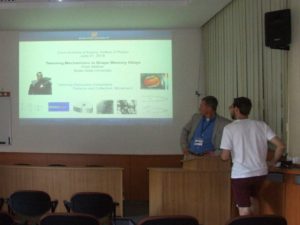Speaker: Peter Mullner (Micron School of Materials Science and Engineering, Boise State
Date: Thursday, 21.06.2018 10:00
Place: Lecture Hall of the Institute of Physics, Pod Vodárenskou věží 1, Prague 8
Abstract:
Functional materials such as shape memory alloys and piezoelectric ceramics deform by twinning. The twinning dislocation – also called disconnection – carries the elementary twinning displacement. To form a mesoscopic twin, large numbers of disconnections propagate collectively. Large disconnection ensembles – often represented as disclination dipoles – create shears and rotations unlike the displacement field of single disconnections. The collective displacement field controls relaxation mechanisms such as twin-twin intersection, several forms of hierarchical twinning, fracture, and type II twinning. Surface treatments that pin twinning disconnections result in a densely twinned microstructure, which is more than three orders of magnitude more resistant to fatigue damage than untreated samples. The patterns of large twin ensembles – and particularly the arrangement of twinning disconnections – control the functional properties of shape memory alloys and other active materials.


